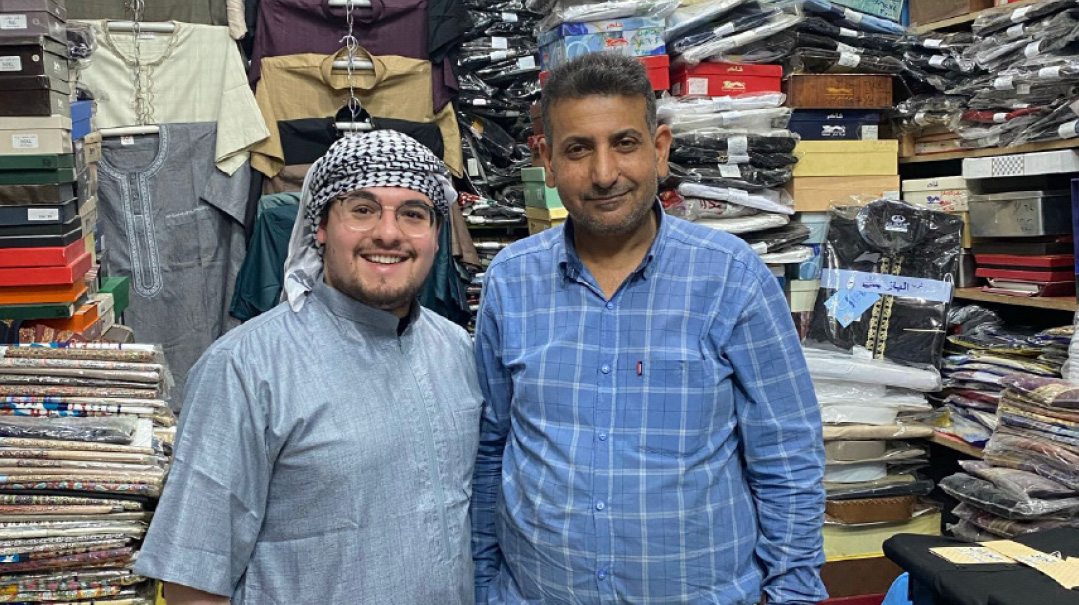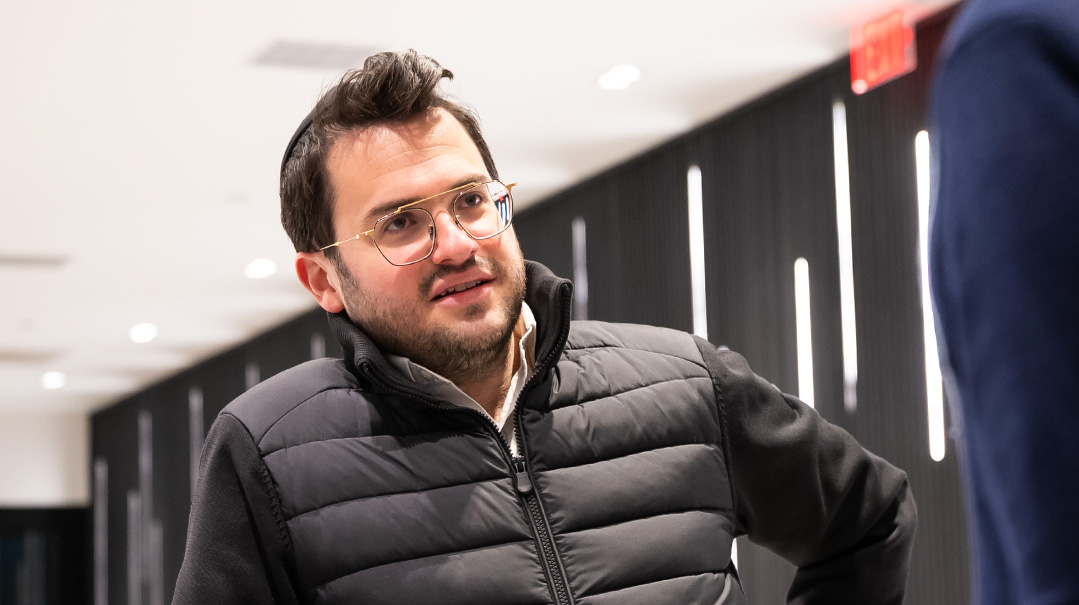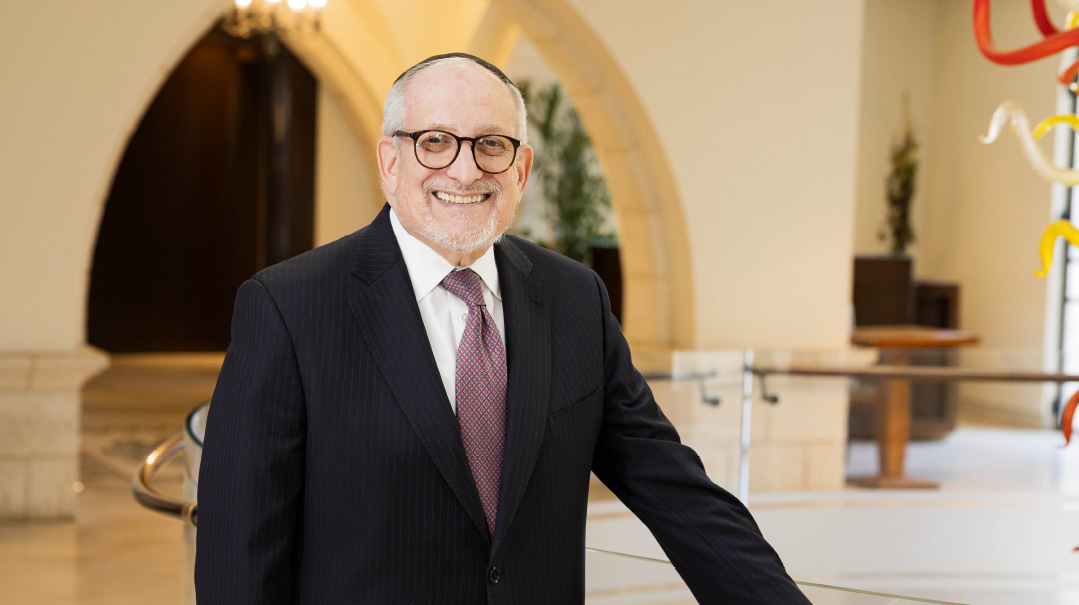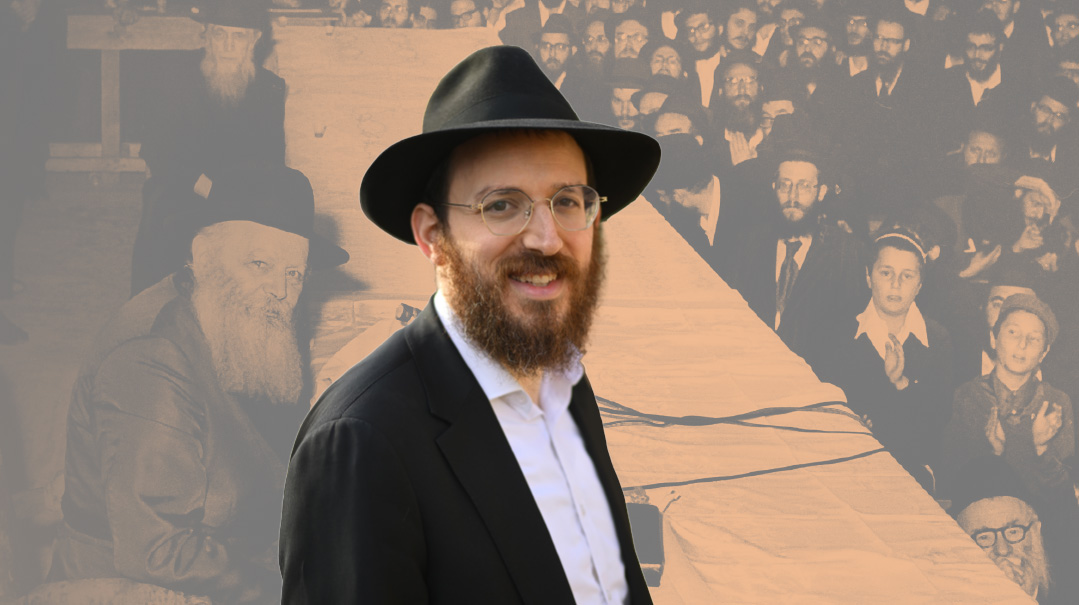Between Iraq and a Hard Place
| September 29, 2024With its rich Jewish history and an infinitesimally small Jewish presence, Iraq beckoned to Moshe Klein

Photos: Moshe Klein
In the course of his worldwide travels, intrepid globetrotter Moshe Klein has visited places that are beautiful, uplifting, and exciting. But if he had to pick one word to describe the country he visited during Aseres Yemei Teshuvah, it would most likely be “dangerous.” Because no matter how many precautions you take, and how careful you try to be, personal safety is never guaranteed when you visit Iraq
Flying Under the Radar
Klein was well aware that Iraq had earned its spot on the State Department’s do-not-travel list, with various militias and ISIS operating freely without fear of governmental reprisal. The fact that the American soldiers who had been stationed in Iraq for 20 years had all been called home, left Klein without a friendly military there to call on in case he got into trouble. And yet, with its rich Jewish history and an infinitesimally small Jewish presence, Iraq still beckoned to Klein.
Joining Klein on his trip was his close friend, a fellow seasoned traveler named Beri. The two were excited by the prospect of being able to daven at significant but rarely visited kevarim during Aseres Yemei Teshuvah. Given the inherent risks in visiting Iraq, Klein hired a fixer, someone well connected with local law enforcement who has his ear to the ground. Not surprisingly, fixers charge top dollar for their services.
“A fixer is someone who knows where it is dangerous and where it is safe, and has the ability to assess a situation within hours,” says Klein. “You might have something on your itinerary and a fixer will tell you not to go there, or he might turn a 90-minute drive into an all-night trip in order to avoid places that are dangerous.”
Klein’s fixer was a gun-carrying Kurd named Ahmed, who advised Klein to book lodging at small guest houses during his trip, since staying in hotels could attract unwanted attention. From the moment he left New York until his return three days later, Klein worked hard to look as inconspicuous and as non-Jewish as he possibly could.
“I didn’t dress chassidish when I boarded our Qatar Airways flight,” says Klein. “I had my peyos hidden under my cap, and I was wearing Nike shoes that I normally wouldn’t be wearing.”
But somehow, Yidden can always recognize a landsman, and despite Klein’s efforts, his cover was blown before his plane to Doha, the capital of Qatar, even took off.
“We were standing there minding our own business when a family from the Five Towns came over and gave us shalom aleichem, and asked us where we were going,” says Klein. “The father was a rabbi, and they were catching a flight to South Africa, where he had been invited to speak, while we were traveling on to Baghdad.”
Thankfully, both legs of Klein’s journey to Iraq passed uneventfully. He did have a few stressful moments when Ahmed called him during his stopover in Qatar to say that he wouldn’t be able to come to the airport in person, and was sending his driver instead.
“I was very nervous, but baruch Hashem, we got our visas right away, and he took us straight to meet Ahmed without any issues,” says Klein.
Tarnished Grandeur
Klein’s first stop in Baghdad was in the old Jewish quarter, located in the Al-Rusafa district on the eastern side of the Tigris River. Klein saw numerous beautiful villas that had once been home to rich merchants, their outer gates carved with Magen Davids. All were empty, their owners having fled the country years ago for safer havens, their beauty and grandeur tarnished by vandals.
Iraq’s Jewish community, which numbered over 70,000 in 1948, had dwindled to just six people when Klein recently visited. Only one shul still stands in all of Iraq — the Meir Tweg Synagogue, located just two blocks northeast of the Tigris. Ahmed took Klein around to the back of the shul, explaining that the front was likely under observation. Built in 1942, the shul is less than 100 years old, but it clearly bears the scars of Iraq’s tumultuous existence. Klein entered the shul from a side door and it was evident right away that it was in desperate need of repair.
“It was a beautiful Iraqi-style shul like you might see in Hong Kong, Singapore, or India, but it was very run down, and there were no siddurim or anything like that,” says Klein.
The sky-blue paint that covered the shul’s walls was peeling in many places, with further disrepair evident at the wooden aron kodesh, whose arched, darker blue-and-white trim echoed the color of the checkered ceiling. Throughout the shul, the wooden benches were covered in white cloth, possibly to protect them from the harsh Middle-Eastern sun.
As much as Klein relished the opportunity to see Iraq’s only shul, he was faced with disappointments every step of the way. With the aron kodesh locked, he was unable to see the shul’s centuries-old sifrei Torah, and the moment he tried to start taking pictures of the historic edifice, Ahmed abruptly told him that they needed to leave. His request to daven in the shul was also rebuffed, so he quickly said a few pesukim and left, heading back outside, where Ahmed told him that they needed to go shopping.
“He told me that I stood out too much and that I needed to wear sheikh clothes, so we went to a clothing store,” notes Klein.
Exchanging his American attire for a black-and-white patterned kaffiyeh to cover his head, and a short-sleeved, floor-length gray jalabiya, Klein appeared less conspicuous. Stopping at an antique shop hoping to discover some banknotes, Klein spied some bechers and besamim boxes, which he picked up and inspected, hoping to find some identifying marks or names. Aiming to make a sale, the shop owner named a steep price for the items, which didn’t sit well with Klein.
“I refused,” says Klein. “I told him they weren’t his and he shouldn’t be asking for those amounts.”
Klein’s shopping led him to one of Iraq’s only living Jews, an elderly widow who had been married to a Muslim man.
“An old Muslim man selling Jewish jewelry noticed my interest in his sechorah and he told me he had a Jewish friend,” says Klein. “She was 91 and we spoke about the Farhud, the 1941 pogrom against Baghdad’s Jews that spelled the end of Yiddishkeit in Iraq. She also told me she says Tehillim every day.”
Grave Concerns
Having studied the Ben Ish Chai’s seforim for many years, Klein was excited to go visit his kever in Baghdad, but making that dream a reality was anything but simple. For starters, Ahmed was leery of going to the Al-Habibiyah Jewish Cemetery. He warned Klein that the area was unsafe, finally relenting when Klein persisted.
But far more problematic was the fact that the location of the Ben Ish Chai’s kever is something of a mystery. While there is no doubt that the Ben Ish Chai was buried in Baghdad after his death in 1909, what happened after the kevurah remains up for debate.
Some say that the Ben Ish Chai is still buried in Baghdad. But the inscription on a matzeivah on Har Hazeisim bearing the tzaddik’s name tells the story of a respected rav who had a dream that the Ben Ish Chai’s remains mysteriously made their way to Israel. The very next day, a gravedigger came to the rav and asked to be paid half a gold lira for burying the Ben Ish Chai on Har Hazeisim.
Further complicating the situation was a government order issued in the 1970s that had the entire beis olam where the Ben Ish Chai was laid to rest relocated outside the city of Baghdad.
Despite those issues, Klein headed to the Al-Habibiyah Jewish cemetery, which, true to Ahmed’s words, was located in a very bad area. Worse yet, the beis hachayim was filled with graves that had been relocated by the government from another cemetery by order of Iraq’s then-leader Saddam Hussein, but none of the gravestones had any inscriptions. Faced with hundreds of unmarked graves, Klein knew there was no way for him to locate the Ben Ish Chai. But he hoped to salvage something from the trip by learning about the cemetery from an older gentleman who had approached and was speaking with Ahmed.
With Ahmed translating, Klein discovered that the man’s father had been the cemetery’s caretaker. The man pointed to a grave at the edge of the cemetery that was tucked under a palm tree, the only place in the entire beis hachayim that wasn’t exposed to the blistering Iraqi sun.
“He explained that his father had told him that that was where they buried the leader of the Jewish People, and it looked like Al-lah was making shade for the tzaddik,” recalls Klein, who couldn’t believe his ears, realizing that he had found the Ben Ish Chai’s kever after all.
Klein made his way over to the palm tree and began to daven with all his heart.
“It was extremely emotional,” shares Klein. “I learned the Ben Ish Chai’s seforim, and I really felt connected to him, like I knew him. It was amazing.”
Playing It Safe
The Ben Ish Chai’s kever wasn’t the only tziyun that Klein was hoping to see in Iraq, but getting to those places was tricky. For safety reasons, Klein had no intention of telling his guide that he was Jewish, his Arabic clothing further camouflaging his identity.
“We weren’t going to say that we wanted to go to only Jewish sites,” explains Klein. “Instead, we told my guide that as part of my heritage, we wanted to see some Jewish cultural sites, among others.”
That strategy worked well, and Klein’s guide interspersed visits to a martyr’s monument as well as several other secular sites into his itinerary. The next stop was one that Klein had chosen — the grave of Yehoshua Kohein Gadol. It seemed appropriate to Klein to visit the kever of the first Kohein Gadol to serve in the Second Beis Hamikdash in the days approaching Yom Kippur. While he had a vague location for the beis olam, Klein was working off a printed map, and the particulars for this stop on his journey were not particularly well defined.
“Iraq in general isn’t exactly a tourist destination, and the kever of Yehoshua Kohein Gadol doesn’t come up on Trip Advisor as highly recommended,” quips Klein. “I knew it was not far from a certain military base, but I was afraid to ask a military jeep where a Jewish kever was.”
It took Klein two hours to identify the right spot. It was located underneath an old bus station that was essentially a junkyard for old trains.
“We had to drive through hundreds of old wagons, and when we finally got there, there were two soldiers there with big weapons,” recalls Klein. “We told them we wanted to go in, but they were hesitant and didn’t want to allow us.”
Klein’s guide recommended that he have a casual conversation with the guard, and then to turn around and say goodbye as if he was leaving. Just as Klein’s guide predicted, the soldiers told them they could come in for a few moments, but they had to leave their passports behind. The request made Klein uncomfortable, but he had come too far to turn back.
They went into a guarded area where there was a small house. Inside were a few people who appeared to be praying. A guard came out to greet Klein, and his guide struck up a conversation with him, inquiring about what was there. The two men spoke in Arabic, the translation leaving Klein dumbfounded as he discovered that Arabs and Jews have differing opinions about who is buried there.
“The guard explained that this was the kever of Yehoshua Bin Nun, the successor of Moses who took the Jews to the promised land,” says Klein. “I was really amazed — he actually used the words Bnei Yisrael. I wasn’t expecting that kind of knowledge. And apparently, we have a machlokes, but we know that it’s the kever of Yehoshua Kohein Gadol.”
Klein made an on the spot decision to identify himself as Jewish, thanking the guard for taking care of the kever, and making it accessible.
“He was happy — it was his first meeting with someone from Bnei Yisrael, and after we davened, he approached us with water and candies,” says Klein. “He refused to take a picture with us, which is pretty much the norm in Iraq. It was definitely an interesting experience.”
Majestic No More
Had it been up to Klein to choose the next stop on their trip, he would have had their driver take them straight to the kever of Yechezkel Hanavi. But with his guide mixing secular spots in with Jewish sites, he had another destination in mind, and Klein found himself at the sprawling ruins of Nevuchadnetzar’s palace, located south of Baghdad.
“While the actual structure was destroyed, it was clear that it had been a big, magnificent building, with strong yesodos,” observes Klein.
Those sturdy foundations prompted Saddam Hussein to build a new palace atop the original structure, excavating enough of the site to locate the ancient walls and use them as the base for what was to become a vanity project for the Iraqi dictator. Workers at the site discovered the foundations of the nearly 50-foot-high Ishtar Gate, constructed by Nevuchadnetzar for idolatrous purposes, with a vivid blue facade that featured the likenesses of creatures that represented the various deities worshipped by the Babylonians.
“It’s mentioned in our mekoros, as well as the way the palace was built like a maze, with doors to each room facing a different direction,” says Klein. “Usually, in a palace, you went from one room straight to another and then another, seeing ministers and chief ministers before finally getting to the malchus. But here it was done differently, so that an enemy entering the palace couldn’t shoot straight ahead and hit the king.”
In addition to the visual aspect, the palace’s labyrinthine design served another purpose, preventing visitors from not only seeing the king, but also zeroing in on his location by hearing his voice.
“The echo goes around,” explains Klein. “I tried it myself, clapping my hands and hearing the echo bouncing back at all angles.”
It wasn’t lost on Klein that he was standing in the palace that had been frequented by Daniel, Chananya, Mishael, and Azarya. A guided tour given by the palace, which is now a tourist attraction, glossed over the structure’s Jewish history. Klein’s attempt to discuss how Koresh had allocated land to the Jews was quickly shut down by the guide giving the tour.
“He said only that Koresh wasn’t well liked and only wanted to highlight the accomplishments of Nevuchadnetzar,” says Klein.
Next up for Klein was a nearby palace that Saddam Hussein had built for himself after the Gulf War. It wasn’t just for its strategic hilltop location that Hussein chose that location; the Iraqi president had reportedly been obsessed with Nevuchadnetzar and considered himself to be his modern-day heir apparent. Finding a spot that overlooked his reconstruction of Nevuchadnetzar’s palace, the dictator gave local villagers a few hours to pack up and leave, building a regal palace in testament to himself where their homes had once stood.
While Klein was able to imagine the palace’s grandeur — an immense throne and a Turkish bath, to name just a few examples — none of that remains today. When Hussein was overthrown, people ransacked his palace, destroying everything they could reach, the grand chandelier and beautifully painted ceiling among the only remnants of its former glory. Today graffiti adorns its cavernous rooms, the angry words a testament to the Iraqi people’s feelings toward a tyrannical leader.
Walking through the two palaces was a surreal experience for Klein.
“When you go to certain places that are rich in Jewish history, like Rome, you always find Yidden around, and you share these looks with each other, and there is a feeling of kinship,” reflects Klein. “Here, I had those machshavos to myself, because there are no other Yidden going to Iraq.”
With Hussein’s reign of terror taking place decades, not centuries, ago, seeing the state of his palace took on a unique meaning for Klein, who remembered how the Iraqi dictator saw himself of the king of the world, and set his destructive sights on Israel.
“Today these ruins are all that is left of him,” observes Klein.
A Close Call
There’s a market that you have to go through in order to get to the kever of Yechezkel Hanavi, the next stop on Klein’s whirlwind tour of Iraq, which involved a lot of driving and very little sleep. Located in Al Kifl, some 90 miles south of Baghdad, the market is in a large building. Visitors to the burial place of Yechezkel Hanavi — a site also holy to Muslims, who believe that it is the resting place of one of their prophets — have to remove their shoes before they can approach the kever.
Having previously seen pictures of the tziyun, Klein knew there were Hebrew letters in some spots, and he cautioned Beri, his travel buddy, not to give any indication that they were able to read what was written there. But Beri got caught up in the moment, and started reading the inscription out loud, changing the tenor of their visit in an instant.
“The secret police came out, dressed in black and wearing earpieces,” recounts Klein. “We knew right away who they were, and the fact that my strong Kurdish fixer was shivering didn’t make us feel any safer.”
The questions began fast and furious, with Ahmed serving as a translator.
“They asked us why we were there, and I did my best to stay calm, telling them we had come here to pray and were amazed at the sight of Christians, Jews, and Muslims all praying together in a holy place,” says Klein.
Whatever Klein was selling, the Iraqi policeman wasn’t buying it. He asked Klein why he was dressed as a sheikh if he was really a rabbi.
“I explained that I appreciated the Iraqi hospitality and didn’t want to stand out and possibly create a situation,” said Klein. “I told him it was important for me to pray here, just like it was for the other people who were there.”
Klein’s explanation seemed to resonate with the officer, whose menacing appearance relaxed somewhat. He invited Klein into his office while he consulted with his superiors, even offering his “guests” some tea, which they politely declined. A few moments later, Klein, Beri, and Ahmed were told they were free to go.
But as the officer escorted them out of the kever, he asked Klein, “So why are you really here?”
The question left Klein momentarily speechless. He wondered if the officer thought he was a spy. What was he supposed to say? Deciding to play it straight, he explained what a neshamah is, and how each one that is born into this world has a unique job all its own.
“I told him how, even when we die, we don’t go to a regular cemetery, only a Yiddishe beis olam, and that once I was in Baghdad, it was important to visit the kever of the Navi and to daven for his neshamah,” recalls Klein.
The officer contemplated Klein’s words for a few moments and then responded, “No, it isn’t the prophet who needs your prayers, it is Baruch.”
For the third time in a matter of just moments, Klein found himself at a loss for words, and he asked the officer to repeat himself, once again hearing that Baruch was in need of Jewish prayers. The officer escorted Klein through a tunnel to an area holding three tombs, all bearing Arabic letters. Pointing to the middle grave, the officer explained that Baruch had been a Jewish advisor to a leader named Ali. Baruch was given an ultimatum — accept Islam or die.
“He told me that Baruch had chosen Islam, and that if someone needed my prayers, it was him, because he had sold his soul for money,” shares Klein. “It was a crazy situation, and an emotional moment. I davened for his neshamah and then we left.”
As the officer accompanied Klein to the exit, he warned him to stay out of trouble. From that moment on until the end of his trip, Klein couldn’t shake the feeling that he was being followed. It is entirely possible that he was just being paranoid, but equally likely that his suspicions were completely on the mark.
History Rewritten
Klein’s next stop was at the kever of Ezra Hasofer in Al Uzair, a nearly five-hour trip into Shiite country that was anything but pleasant.
“There are lots of checkpoints, and at every one, they look at your passport and where you’ve been,” notes Klein. “You always feel that klop in your heart, wondering if they’re going to give you any problems.”
Located on the banks of the Tigris River with sweeping views, the kever itself was a beautiful compound, which was once housed a shul. Still, the visit was unsettling to Klein, who once again saw evidence of the area’s rich Jewish history being slowly but surely eradicated.
“You could see on the kever that there was plywood added on that had Arabic lettering,” says Klein. “But if you looked behind it, you could see the historic Hebrew engravings that they were trying to cover up.”
Those same unnerving feelings surfaced when Klein’s guide took him to Al-Mutanabbi Street, Iraq’s book market. As his guide explained, the market is open at all hours and never closes, because of the Iraqi belief that readers don’t steal and thieves don’t read.
“It was interesting to see, but when I asked to see some of the best sellers, Mein Kampf was one and The Protocols of the Elders of Zion was another,” notes Klein. “So I decided to move on.”
After spending two and a half nearly sleepless days in Iraq, Klein couldn’t have been more excited to head back home to Brooklyn, arriving at JFK Airport on the morning of Erev Yom Kippur. As he sat down in shul that night, Klein’s head was filled with memories of his whirlwind trip to Iraq.
“I thought about the Yidden who are left,” says Klein. “I thought about the Jewish sights that are being erased. I thought about how I had just davened at the tziyun of Yehoshua Kohein Gadol, and I davened that we should all be ois geleist — that we should be redeemed, and here we are now, and it is so clear just how badly we need that to happen.”
(Originally featured in Mishpacha, Issue 1031)
Oops! We could not locate your form.







